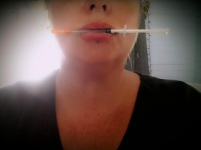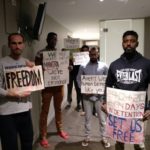Women – the Invisible Drug War Casualties: An Interview With IAWUD’s Freedom Vivian

The war on drugs has been waged for close to fifty years now. In 1971, the Nixon administration heralded in this intensification of drug law enforcement, which has resulted in the mass incarceration of people who use drugs, and military interventions in nations of the global south.
The backdrop to the war is the international system of drug prohibition, which, over the last century, has seen greater restrictions placed on certain psychotropic substances, via a series of international drug conventions and domestic drug laws.
The casualties of war
Of course, some of the heaviest casualties of the drug war have been people who take illicit substances. The illegality of drugs has led to heightened risks and harms associated with their use, as the threat of punishment pushes those that partake in these substances underground.
Young Australians who take party drugs at festivals continue to die because bad batches of drugs are circulating on the black market, where no quality controls exist. And authorities continue to deny these youths access to testing equipment that saves lives.
While on the streets of North Richmond, an opioid overdose crisis has been escalating over the past five years. But, in a win for local residents and those people who take these drugs, it will all come to an end soon, as the state government has agreed to trial a supervised injecting facility.
Mobilising to reduce harms
Harm reduction consists of a range of health approaches that are designed to lessen the negative consequences associated with certain behaviours.
In the case of recreational drug use, a lot of these harms are caused by the threat of incarceration and the unregulated nature of the illegal drug market.
In mid-1980s Sydney, Australian Drug Law Reform Foundation president Dr Alex Wodak led the campaign to implement needle and syringe programs (NSPs) nationally in the face of the pending AIDS epidemic.
And a group of drug injecting locals from the inner city began working with the doctor and his team on the initial NSP in Darlinghurst. This group went onto become the NSW Users and AIDS Association (NUAA), the peak drug user organisation in the state.
Since then, organisations of activists who use drugs have mobilised globally. They’ve begun playing an integral role in harm reduction and drug law reform. And at the 2005 International Harm Reduction Conference, the International Network of People Who Use Drugs (INPUD) was formed.
The invisible casualties
Women have often been described as the invisible casualties of the war on drugs. Women who use drugs face gender-based issues such as an increased likelihood of domestic violence, the removal of children, and an aggravated risk of contracting blood-borne viruses.
And it’s due to these specific issues that networks of women who use drugs have begun to form. The International Alliance of Women who use drugs (IAWUD) is one such group that provides women-only spaces, where challenges being faced can be shared, along with support.
Sydney Criminal Lawyers® spoke with Freedom Vivian, spokesperson for IAWUD, about the issues that emerge for women under drug prohibition, the need for women-specific networks, and the failure of Australia to keep up its former status as a “world leader” in harm minimisation.
Firstly, drug prohibition has been around for about a century now, and the war on drugs has been going since 1971.
What would you say have been the overall effects of this system of illegal drugs?
Without a doubt prohibition has been making drugs more dangerous since 1971.
Making drugs more dangerous for the individual, the community and society in general. What is referred to as “drug-related harm,” from accidental overdoses to the emergence of designer drugs, is actually harms related to prohibition.
Drugs are a multibillion dollar industry coming in second after weapons. Essentially, the industry is run by criminal cartels and gangs, as well as their corrupt partners. Drug dealers are business people responding to a demand, and they manufacture a product to sell. Business 101 – supply and demand.
Under prohibition, drug cartels have learnt to adapt their business model. All costs from transportation to bribes are factored into the cost price. To reduce the risks of being busted by police the drug growers and manufacturers now need to produce smaller products and stronger drugs, such as more powders.
Marijuana grown naturally without chemicals would have to be one of the most benign drugs. Under prohibition, why would anyone risk exposing themselves and getting busted growing cannabis naturally outdoors for 12 months? When they can grow it in 3 months using hydroponic chemicals and growth hormones under lights, which makes the cannabinoids and final product less stable.
Or even better, why not make a batch of meth in less than 8 hours in a hotel room? And the recent emergence of Fentanyl is a classic example. Why risk bulky plant matter or powders when there is a product that is 50 to 100 percent times stronger? It’s so much easier to conceal, more potent, cheaper to transport – it just makes good business.
Every time the police take a cook or dealer off the street it creates a void which is filled almost instantly by the first available operator. However, this instability is what puts people’s lives at risk.
Product and potency fluctuates, and prices alter due to the cook’s knowledge. In an unregulated market that knowledge varies.
People who have years of knowledge know how to make amphetamine product that is pH balanced and stable. Whereas a cook with year nine chemistry will create bad batches of ice. However, all batches make it to market, regardless of its quality. There is so much money to be made
And out of this system of prohibition, what are some of the issues that have emerged specifically for women?
Prohibition impacts disproportionately on women. Women are more likely to be taken advantage of or ripped off by dealers, other users and police.
The police often lean heavily on women, threatening to take their children away if they do not give up their boyfriends or husbands, or help them with their investigations.
The stigma of being seen as a “user” is particularly harsh especially in the court setting. Women with children are more likely to lose custody of their children compared to their male counterparts who are seen and treated as “bad boys.”
At the 2006 International Harm Reduction Conference, the Vancouver Declaration was produced. It was a statement regarding the goals and values of people from around the globe who use drugs.
What was outlined in the declaration?
In April 2006, in Vancouver Canada, a small group of activists and peers set out the International Network of People Who Use Drugs’ (INPUD) foundational document “Nothing about us without us: a manifesto by people who use illegal drugs.”
It’s essentially a declaration of human rights – rights which are routinely denied to people who use drugs. The opening passage reads:
“We are people from around the world who use drugs. We are people who have been marginalized and discriminated against, we have been killed, harmed unnecessarily, put in gaol, depicted as evil, and stereotyped as dangerous and disposable. Now it is time to raise our voices as citizens, establish our rights and reclaim the right to be our own spokespersons striving for self-representation and self-empowerment:
To enable and empower people who use drugs legal or deemed illegal worldwide to survive, thrive and exert our voices as human beings to have meaningful input into all decisions that affect our own lives.”
Today, there are numerous networks of people who use drugs globally. But, women who use drugs face specific obstacles within them.
What are some of the issues that women face within these organisations that they’re a part of?
The most obvious issue we have as activists and women is that funding opportunities are rare, and our initial sources of funding and resources were tied up with INPUD and other drug user organisations all of which were run by men.
Unfortunately, within INPUD, the International Network of Women Who Use Drugs (INWUD) was a bit of an afterthought, rather tokenistic and has been heavily controlled by INPUD, which proved problematic.
So, due to these issues women-only networks have formed. And one of them is the International Alliance of Women Who Use Drugs.
Can you tell us a bit about the evolution of your group? And what sort of changes it has brought about for the women involved?
In 2016, the alternate INWUD representative to the INPUD board was removed from her position in what can only be described as dirty politics and an underhanded act of dominance by the board.
This unethical act raised questions about the autonomy of INWUD, if its representative could be effectively dismissed by INPUD. And that was the catalyst to the formation of the International Alliance of Women who use drugs (IAWUD).
IAWUD formed organically and at this stage is an online space created by its members.
We are a grassroots collective of women drug users and activists from around the world who have come together in the spirit of trust and solidarity to end prohibition and to give an opportunity to women who use drugs for meaningful engagement, as opposed to the previous tokenistic engagement.
IAWUD provides women-only safe spaces for its members. How vital is this provision? And what sort of things would you say having this safe space achieves?
This particular group has members from all over the world. Drug use is illegal in most countries with penalties that can even result in death.
To have a space where there is no judgement and only positive regard, to be able to speak openly, to seek advice, to know you don’t have to edit yourself and to have your voice be counted is very empowering.
For some women this online space is the only space they have to talk about issues that affect them on a day-to-day basis.
On the Australian scene, there was a harm reduction victory in late October, as Victorian premier Daniel Andrews announced that a safe injecting room will be established in North Richmond.
This is the second such facility in Australia. The Kings Cross medically supervised injecting centre opened in 2001.
What did you think about the Victorian development last year?
It frustrates me that despite all the evidence it still took 14 years to enact change and it saddens me that so many people died unnecessarily in Victoria.
These are my peers and for me the political is personal. Every success or advance we have also comes with a tinge of anger that it took so long.
In many ways, Australia was a world leader in harm reduction, when NSPs were rolled out in the 1980s, and then when the Kings Cross centre became the first such facility in the English-speaking world.
What do you think about the situation in regard to harm reduction in Australia today? And what are the most pressing harm reduction issues at present?
Australia’s response to the HIV threat in the 1980s was world class, without a doubt. The Labour prime minister Bob Hawke had been personally touched by the war on drugs, with his daughter battling substance use disorder.
Hawke knew that too many young people would die if something drastic wasn’t done. He listened to the evidence-based science. And the stats were in, so Hawke financed needle and syringe programs and other harm reduction methods.
Because of this progressive stance Australia has one of the lowest HIV rates amongst people who use drugs. And Hawke’s daughter survived and went on to live an otherwise happy and prosperous life.
Sadly, subsequent Liberal/National governments have not embraced the proud forward-thinking tradition of their predecessor.
And although we still have clean needle programs and NSPs, our funding has been cut dramatically and subsequently Australia’s hep C rates are through the roof. And we are no longer seen as world leaders in the fight against HIV.
And lastly, back to the prohibitionist system. Over recent years, numerous institutions and individuals have declared that the war on drugs has failed.
And some governments, such as Portugal and now Norway, have heeded these calls, and moved towards decriminalisation models.
Do you think we’ll be seeing an end to the war on drugs anytime soon? And what do you foresee developing in the near future?
The war on drugs has never been about drugs. It was designed by the US administration as a political tool to infiltrate domestic “threats,” such as African American and left-wing groups uprising in the US.
It is the longest running war ever fought by governments against its own people.
Despite everyone from the HIV sector and wider medical profession, the legal profession, economists, and even environmentalists, coming out against prohibition, the reality is that this is about vested interests.
The corruption is widespread and goes all the way to the top. People are making money left, right and centre from both illegal and legal means.
But, with the prison-industrial complex with its privatised gaol system using inmates as slave labour with no rights, to the manufacturers of the drug testing kits, and the labs that analyse the tests kits, to the entire ‘drug and alcohol sector’- frankly I’m pessimistic.
There’s too much money being made to ever end this war.







